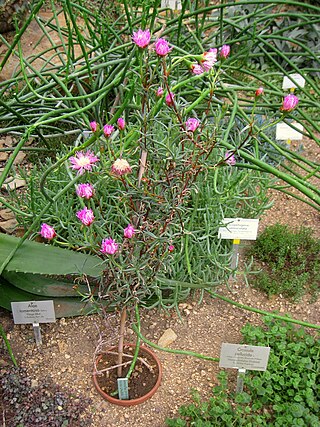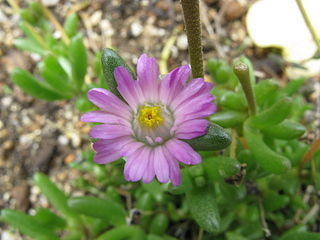Trailing iceplant or trailing ice plant may refer to the following plant species:
- Delosperma cooperi
- Lampranthus glaucoides , syn. Lampranthus aurantiacus
- Lampranthus aureus
- Lampranthus spectabilis
- Lampranthus zeyheri
Trailing iceplant or trailing ice plant may refer to the following plant species:
Cypress is a common name for various coniferous trees or shrubs of northern temperate regions that belong to the family Cupressaceae. The word cypress is derived from Old French cipres, which was imported from Latin cypressus, the latinisation of the Greek κυπάρισσος (kyparissos). Cypress trees are a large classification of conifers, encompassing the trees and shrubs from the cypress family (Cupressaceae) and many others with the word cypress in their common name. Many cypress trees have needle-like, evergreen foliage and acorn-like seed cones.

Lampranthus is a genus of succulent plants in the family Aizoaceae, indigenous to southern Africa.

Ruschia is a genus of succulent plant, in the family Aizoaceae, indigenous to the dryer parts of southern Africa.
Ice plant or iceplant may refer to:

Oscularia deltoides, the deltoid-leaved dewplant, dassievygie or sandsteenvygie is a species of flowering succulent plant in the fig-marigold family Aizoaceae that is native to the south-western Cape, South Africa.

Lampranthus sociorum is a species of plants in the family Aizoaceae.

Cape Flats Dune Strandveld is an endangered vegetation type. This is a unique type of Cape Strandveld that is endemic to the coastal areas around Cape Town, including the Cape Flats.

Peninsula Granite Fynbos is an endangered Fynbos vegetation type which is endemic to the city of Cape Town and occurs nowhere else. It is a unique type of tall, dense and diverse scrubland, scattered with trees. It can be found all along the belt of granite that encircles Table Mountain.

Bracken Nature Reserve is a 36-hectare (89-acre) piece of protected land in Brackenfell in the Western Cape, South Africa.

Lampranthus tenuifolius, the narrow-leaf brightfig, is a critically endangered species of succulent plant that is endemic to the Cape Flats Dune Strandveld around Cape Town, South Africa.

Lampranthus glaucoides, synonyms including Lampranthus aurantiacus, known as the trailing iceplant and copper brightfig, is a plant species in the genus Lampranthus native to South Africa and naturalized in gardens all around the world. It was first described by Adrian Hardy Haworth in 1795 as Mesembryanthemum glaucoides.
Trailing bellflower is a common name for several ornamental plants in the bellflower family and may refer to:

Tokai Park, previously known as "Tokai Forest", is a small wing, about 600 ha, of the greater Table Mountain National Park in Cape Town, South Africa. Tokai Park is made up of two sections: upper and lower Tokai Park. Lower Tokai Park is flat, and characterized by the threatened Cape Flats Sand Fynbos. Upper Tokai Park is on the slopes of Constantiaberg Mountain, and consists of conservation area as well as the Tokai Arboretum. Upper Tokai Park is characterized by Peninsula Granite Fynbos, Peninsula Sandstone Fynbos and Afromontane Forest and noted for its diversity.

Lampranthus glaucus is a plant species in the genus Lampranthus native to South Africa and naturalized in gardens all around the world.

Lampranthus aureus is a species of shrub in the family Aizoaceae. They are succulent plants. They have a self-supporting growth form and simple, broad leaves.

Lampranthus multiradiatus, synonyms including Lampranthus roseus, known as the creeping redflush or rosy dewplant, is a species of shrub in the family Aizoaceae. They are succulent plants with grey-green shoots. They have a self-supporting growth form and simple, broad leaves. The daisy type flowers have yellow centres and petals that vary between pink and purple depending on the season.

Lampranthus spectabilis, the trailing iceplant, is a species of flowering plant in the family Aizoaceae, native to the Cape Provinces of South Africa. The unimproved species and a number of cultivars are commercially available, including 'Tresco Apricot', 'Tresco Brilliant', 'Tresco Fire', 'Tresco Orange', 'Tresco Peach', 'Tresco Pearl', 'Tresco Purple', and 'Tresco Red'.

Lampranthus zeyheri, the trailing iceplant, is a species of flowering plant in the family Aizoaceae, native to the eastern Cape Provinces of South Africa. It is occasionally planted as an ornamental.

Lampranthus bicolor, the bicoloured lampranthus, is a species of flowering plant in the family Aizoaceae, native to the southwestern Cape Provinces of South Africa. A spreading succulent reaching 30 cm (12 in), it prefers to grow in sandy areas.